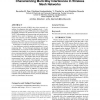Free Online Productivity Tools
i2Speak
i2Symbol
i2OCR
iTex2Img
iWeb2Print
iWeb2Shot
i2Type
iPdf2Split
iPdf2Merge
i2Bopomofo
i2Arabic
i2Style
i2Image
i2PDF
iLatex2Rtf
Sci2ools
MOBICOM
2006
ACM
2006
ACM
Characterizing multi-way interference in wireless mesh networks
Wireless mesh networks (WMNs) have been proposed as a solution for ubiquitous last-mile broadband access. A critical limiting factor for many WMN protocols in realizing their throughput potential is the interference between nodes in the WMN. Understanding and characterizing such interference is important for a variety of purposes such as channel assignment, route selection, and fair scheduling. Instead of using ad hoc heuristics, a recent study proposed characterizing interference in a WMN by measuring two-way interference, i.e., interference between each pair of communicating links. In this paper, we study the extent of multi-way interference, i.e., the interference caused by multiple transmitters to a communicating link. We find through simulations and through measurements of a 32-node wireless testbed that even if these transmitters individually do not interfere significantly with a given communicating link, simultaneous transmissions of them have the potential to significantly ...
| Added | 14 Jun 2010 |
| Updated | 14 Jun 2010 |
| Type | Conference |
| Year | 2006 |
| Where | MOBICOM |
| Authors | Saumitra M. Das, Dimitrios Koutsonikolas, Y. Charlie Hu, Dimitrios Peroulis |
Comments (0)

